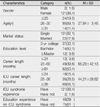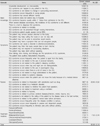Abstract
Purpose
This study was to investigate intensive care unit (ICU) nurse's knowledge and nursing performance on the intensive care unit syndrome.
Method
A survey questionnaire was administered to a convenience sample of 123 nurses in a university hospital. Data were collected from August 1st to August 25th, 2009. Data were analyzed using SPSS/WIN 12.0.
Results
The mean score for knowledge and nursing performance were66.96 and 74.97 respectively. According to the general characteristics, there were significant differences in knowledge depending on marital status, education level and career length and in nursing performance depending on their age, education level and career length. The correlation between knowledge and nursing performance was a significant positive one.
Figures and Tables
References
1. Arnold E. Sorting out the 3 D's : Delirium, dementia, depression: Learn how to sift through overlapping signs and symptoms so you can help improve an older patient's quality of life. Holist Nurs Pract. 2005. 19(3):99–104.
2. Bross HM, Tatum NO. Delirium in the elderly patients. Am Fam Physician. 1994. 50(6):1325–1332.
3. Cho GI. ICU nurses's knowledge and nursing performance of intensive care unit syndrome. 2001. Seoul: Ewha Womans University;Unpublished master's thesis.
4. Dyer I. Preventing the ITU syndrome or how not to torture an ITU patient! Part 1. Intensive Crit Care Nurs. 1995. 11:130–139.
5. Ely EW, Shintani A, Truman B, Speroff T, Gordon SM, Harrel FE, Inouye SK, Bernard GR, Dittus RS. Delirium as a predictor of mortality in mechanically ventilated patients in the intensive care unit. JAMA. 2004. 291(14):1753–1762.

6. Jang IS, Choi MH. The effect of the environmental nursing intervention on ICU delirium, environmental stress and sleep in patients underwent cardiac surgical procedures. J Korean Clin Nurs Res. 2008. 14(2):127–138.
7. Jang KE. ICU nurses's knowledge and nursing activities for ICU syndrome. 2008. Seoul: Yonsei University;Unpublished master's thesis.
9. Kang HJ. The relationship between knowledge and stress ICU psychosis, perceived by ICU nurses. 2005. Nonsan: Konyang university;Unpublished master's thesis.
10. Kim YH. ICU psychosis experience of nurse in intensive care unit. 2005. Seoul: Yonsei University;Unpublished master's thesis.
11. Lin SM, Huang CD, Liu CY, Lin HC, Wang CH, Huang PY, et al. Risk factors for the development of early-onset delirium and the subsequent clinical outcome in mechanically ventilated patients. J Crit Care. 2008. 23(3):372–379.

12. Maguire GP. Unplanned extubation in the intensive care unit: A quality of care concern. Crit Care Nurs Q. 1994. 17(3):40–47.
13. McMillan SC, Tittle M, Hagan S, Laughlin J, Tabler RE. Knowledge and attitudes of nurses in veterans hospitals about pain management in patients with cancer. Oncol Nurs Forum. 2000. 27(9):1415–1423.
14. Micek ST, Anand NJ, Labile BR, Shannon WD, Kollef MH. Delirium as detected by the CAM-ICU predicts restraint use among mechanically ventilated medical patients. Crit Care Med. 2005. 33(6):1260–1265.

15. Miller J, Neelon V, Champagne M, Bailey D, Ng'ande N, Belyea M, et al. The assessment of acute confusion as part of nursing care. Appl Nurs Res. 1997. 10(3):143–151.

16. Minjoong essence korean dictionary. 2007. 6th ed. Seoul: Minjoongseorim.
17. Park KY. Rational emotive behavioral therapy. 2007. Seoul: Hakgisa.
18. Park MH, Lee BS. The use of restraints in ICU of hospitals at taegu and kyungbuk area in korea. Korean Jungang Med J. 1997. 62(2):217–227.
19. Price AM. Intensive care nurses' experiences of assessing and dealing with patient's psychological needs. Nurs Crit Care. 2004. 9:134–142.

20. Pun BT, Gordon SM, Pererson JF, Shintani AK, Jackson JC, Foss J, et al. Large-scale implementation of sedation and delirium monitoring in the intensive care unit: A report from two medical centers. Crit Care Med. 2005. 33(6):1199–1205.

21. Roberts B. Screening for delirium in an adult intensive care unit. Intensive Crit Care Nurs. 2004. 20:206–213.

22. Sax H, Perneger T, Hugonnet S, Herrault P, Chraiti MN, Pittet D. Knowledge of standard and isolation precautions in a large teaching hospital. Infect Control Hosp Epidemiol. 2005. 26:298–304.

23. Seo HJ. Intensive care unit nurses's knowledge, nursing performance and stress about delirium. 2006. Seoul: Catholic University;Unpublished master's thesis.
24. Shin ES. Stress abd burden of the open heart surgery patient's family in the ICU. 2002. Gwangju: Chonnam National University;Unpublished master's thesis.
25. Thomason JW, Shintani A, Peterson JF, Pun BT, Jackson JC, Ely EW. Intensive care unit delirium is an independent predictor of longer hospital stay: a prospective analysis of 261 nonventilated patients. Crit Care. 2005. 9:R375–R381.
26. Webb JM, Carlton EF, Geehan DM. Delirium in the intensive care unit: Are we helping the patient? Crit Care Nurs Q. 2000. 22(4):47–60.

27. Yang YA. ICU nurses's knowledge and nursing performance on patient's symptoms of delirium. 2006. Seoul: Catholic University;Unpublished master's thesis.
28. Yu MY, Park JW, Hyun MS, Lee YJ. Factors related to delirium occurrence among the patients in the intensive care units. J Korean Clin Nurs Res. 2008. 14(1):151–160.




 PDF
PDF ePub
ePub Citation
Citation Print
Print







 XML Download
XML Download